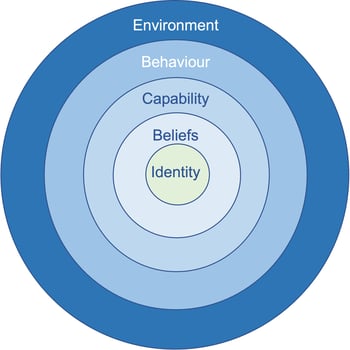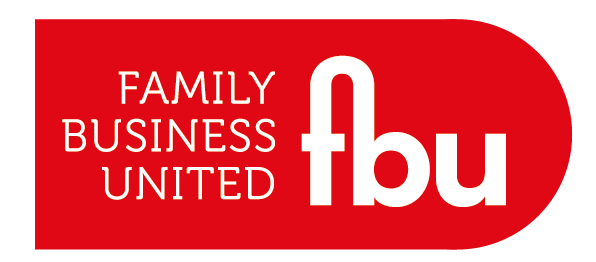Contact me at: nick.mayhew@alembicstrategy.com
Far from the hoped-for flourishing of family relationships, with members happily working together, family businesses are all too often a place of tension and conflict. This can be personalised, centred on individuals with judgement, blame, frustration and anger. In this article we explore the environmental sources of conflict, where paradoxes and polarities arise constantly and naturally, driving these tensions. We suggest a different way of framing conflict: as environmental rather than personal, which gives family business leaders clues for new approaches so that they can return to flourishing.

Let’s start with some definitions. Firstly, environment. A good way to describe this is using a reference to Robert Diltz’s model of The Logical Levels of Change.
At the centre of the levels of change is the story of the self: identity.
Family business members will resonate with this word – it is something of a blessing and a curse. On the one hand it can empower the family brand. However, its centrality here also tells us it is the hardest aspect to change. Identity can give family members a distorted emotional attachment to anything happening in the business as it can be seen as “about them” - personalising policies. We will come back to this under paradoxes and polarities.
As you move out through the circles in the model, things gradually get easier. Habits are hard to change but easier than who we are. We can all learn new things. We change behaviours constantly, and you can easily change the environment.
Conflict is normally presented at behaviour and capability levels. ‘James and Pete keep fighting, we have tried to fix things but cannot work out how.’
You can move up or down the levels for solutions. If you frame the argument as personal, you will tend to go down deeper in the model and work on training, shared values, and beliefs, perhaps habits. If this does not resolve things, identity can come into focus; are we the right people to lead this business? Are you right for this? It can become pretty existential.
Of course, all of these are hard work and we are ignoring the easiest level of change – environment.
Environment here “holds” everything within the circles. It is made up of all the levels. It also includes the way all the business and family activities interact relationally, with each other and the outside world. One way we like to think of this is that the individual capabilities and habits of all the leaders come together as a whole shared intelligence: the collective intelligence of the board. This is the environmental intelligence in which each board member operates. They can only work with the capability of their colleagues, so it is an environment that can empower or limit their own intelligence. Is your family leadership plus when you come together, equal to, or minus? An interesting question.
As you improve the environment, you can do more useful things within it. This is known as stigmergy in cognitive science and is a natural phenomenon. For example, as bees build the hive, more space for making honey appears. The bees’ behaviour changes to making honey and baby bees. We do the same. This does not just apply to the structure of our environment, like a well-designed warehouse, factory or office space. It applies equally to the abilities of the group. As we improve our individual abilities, our shared potential rises, just like the bees and the hive. The shared abilities are part of the environment of the individual and help them achieve more.
Let’s come to polarities and paradoxes. We have already framed conflict as interpersonal tensions, and while we suggest they do not start with individuals, this is how they will be most familiar to business leaders. Something comes up and people have different views, tensions rise and the dialogue can quickly fall into familiar patterns of interpersonal conflict. This often includes the language and tonality of criticism, contempt, defensiveness and stonewalling, Malcolm Gladwell’s four horsemen of relational breakdown.

While the individuals are responding, what are they responding to?
Conflict is really another word for paradox or polarity. This simply means that the energies of the business enter a context where opposing needs are finely balanced and cannot easily be prioritised. The competing needs are the poles, and tension is a good way of describing something that should be moving but has got stuck. The energy builds up as heat, which radiates and dissipates rather than flowing – a good analogy for the frustration, anger and stress we can feel.
Management can often be about resolving these conflicts, between supply and demand, quality and quantity, product and service, fixed costs and variable costs etc. When we see conflicts arise in operational aspects of the business, we problem solve. Normally this resolution of conflicts adds value and helps the business move forwards.
At a leadership level, the conflicts are embodied in the key roles, and different sides of the polarity are held by specific leaders or managers. At the board we design this in. For example, the Chief Executive is often chosen for their future orientation, energy for change and strategies of growth, while the Chief Operating officer is chosen for their ability to organise great service now, fulfilling the demands of the present moment in a masterful way, and looking inwards and sustaining things.
This is a generalisation to make a point: individuals can become personally identified with different, valid needs in the business that pull in different directions. We rely on their human qualities of collaboration, emotional and social intelligence to find the balance between fighting their corner and resolving the paradox to serve both needs.
So, let’s finally examine the additional complexity of a family business. Family members work together and sometimes live together. Polarities include informality and professionalism, work and home life, control and freedom, letting go and holding on.
Let’s examine informality and professionalism in the context of status. In the family, status is informal, organic, and natural. Family members fall into habits of dominance and submission, which are challenged during the teenage years as children stretch their freedom to become adults. While this also happens in work settings, the prime status is formal and contractual. The subtle shift in community status between the environment of home and the environment of work requires conscious and careful navigation. Status is habitual, expressed in tone of voice and body language as much as anything. Expressing home life habits in the presence of work colleagues betrays an intimacy, which humans normally spot in an instant.

It is common for the senior status family member to feel undermined by the casual approach of a more junior sibling, especially in front of professional colleagues. While this needn’t be a problem, it nearly always is, and the public nature of the stress point will often distort feelings and behaviours: bigger rows, sharper put downs, and more deeply felt hurts happen.
So, in the environment of a senior leadership meeting, the tension between the private and public status of two siblings, who perhaps joined the business in different roles at different times, needs more care than for non-family employees.
The potential for conflict is obviously there, caused by this polarity. Given it crosses the lines of family and work, work is not the obvious place to solve it – the solution must work in both environments. Here the tension is going to persist – it is environmental. How are we going to solve it then?
The answer lies in the logical levels. We will need to change the relational dynamic of the parties by addressing things structurally, and habitually, we will need a bag of problem-solving tools to do this, so that both become more capable of spotting and navigating the flash points.
Environment level: Make clear breaks between the work and home environment.
Behaviour level: Conscious agreement is needed. What are the behaviours that will be expressed in the tense contexts e.g. the senior leadership meeting? What are the relational trip wires and hand grenades are that should be carefully packed away?
Capability level: Dialogue around the flash points with an experienced facilitator will reveal the subtle habits of expression in words, tone and body that trigger the trip wires. These need to be made conscious and unpicked, and new habits of expression need to be found. Habit loop tools can be helpful here. Creativity and courage are needed.
Belief level: Do both parties believe they need to address this? Do they believe that they care about each other? And from a family point of view, do they believe that they will protect each other’s need for respect, reliability, and responsiveness in the stressful contexts?
Identity level: Do these siblings see themselves as successful family business members and are they ready to accept the behaviours and environmental changes that support this identity?
While it might seem like there’s a lot to do here, that’s to be expected. It is complex. In practice, the above will often result in a recognition of the issues and a few subtle changes to help make the environment easier, which in turn will support the effortful process of remembering not to do something you have done for years!
Here we have talked about two family business members experiencing tension between the informality of home life in a formal work context. Perhaps prior to reading this you would have said it’s six of one and half a dozen of the other and tried to get them to control their behaviour. Hopefully I have pointed out that they are within a stressful context, naturally, and it is not their fault. Neither is to blame, and both deserve our compassion. We need to improve the capabilities of both parties and their environment. Firstly, to make it easier for them, and then (with luck) to use the context for them both to grow as leaders and humans from the experience, improving their confidence in the process.
About the Author:
Nick Mayhew, MA FCA, is a leadership facilitator and coach. He is founder and managing director of Alembic Strategy, an advisory business that helps the people who own and lead family businesses tackle some of their most significant challenges, enabling people and organisations to grow and to change. He has wide ranging leadership experience as a former equity partner and board member of a large professional firm, as a non-executive director and as a chair.
You can email him at nick.mayhew@alembicstrategy.com and find him on Linkedin here (https://www.linkedin.com/in/mayhewnick/).




